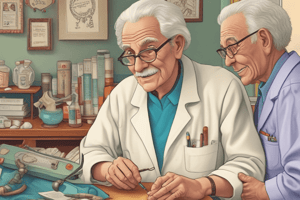Podcast
Questions and Answers
What does the acronym GEMS stand for?
What does the acronym GEMS stand for?
Geriatric, Environment, Medical assessment, Social network
Why was GEMS diamond created?
Why was GEMS diamond created?
It serves as an acronym for the issues to be considered when assessing every older patient.
What is polypharmacy?
What is polypharmacy?
The use of multiple medications by a patient, typically seen in elderly people.
Define unilateral pedal edema.
Define unilateral pedal edema.
What questions are important to ask when assessing why an elderly patient fell?
What questions are important to ask when assessing why an elderly patient fell?
Why are older patients more likely to sustain closed head injuries such as subdural hematomas?
Why are older patients more likely to sustain closed head injuries such as subdural hematomas?
In an elderly patient with a hip fracture, why is it important to use blanket rolls?
In an elderly patient with a hip fracture, why is it important to use blanket rolls?
Why is it sometimes difficult to determine if an elderly patient is in shock based on their blood pressure?
Why is it sometimes difficult to determine if an elderly patient is in shock based on their blood pressure?
Patient care for a pulmonary embolism should focus on what?
Patient care for a pulmonary embolism should focus on what?
Geriatric patients are at risk for atherosclerosis resulting in what?
Geriatric patients are at risk for atherosclerosis resulting in what?
Specific legal documents that direct relatives and care providers about treatment for patients who cannot speak for themselves is known as what?
Specific legal documents that direct relatives and care providers about treatment for patients who cannot speak for themselves is known as what?
An examination of the geriatric patient's residence for safety and well-being falls under which aspect of the GEMS diamond?
An examination of the geriatric patient's residence for safety and well-being falls under which aspect of the GEMS diamond?
Determining the chief complaint in the older medical patient is what?
Determining the chief complaint in the older medical patient is what?
Sudden unconsciousness in the older patient from standing too quickly, bearing down for a bowel movement, or heart attack is called what?
Sudden unconsciousness in the older patient from standing too quickly, bearing down for a bowel movement, or heart attack is called what?
Symptoms such as difficulty breathing and syncope in the older patient often indicate what?
Symptoms such as difficulty breathing and syncope in the older patient often indicate what?
Why may children appear to have experienced a serious injury despite little or no outward signs?
Why may children appear to have experienced a serious injury despite little or no outward signs?
Which of the following is a consideration when immobilizing a small child with a suspected head and neck injury?
Which of the following is a consideration when immobilizing a small child with a suspected head and neck injury?
In the pediatric patient, when immobilization is necessary, what part of the body should be secured to the immobilization device first?
In the pediatric patient, when immobilization is necessary, what part of the body should be secured to the immobilization device first?
Immobilization is necessary for all children who have what possible injuries?
Immobilization is necessary for all children who have what possible injuries?
What are the 6 steps in order when immobilizing a pediatric patient to an immobilization device?
What are the 6 steps in order when immobilizing a pediatric patient to an immobilization device?
Flashcards are hidden until you start studying
Study Notes
GEMS Diamond
- GEMS stands for Geriatric, Environment, Medical assessment, Social network.
- Created to address issues in assessing older patients without replacing basic care principles.
Polypharmacy
- Refers to the simultaneous use of multiple medications, common among elderly individuals.
- Can lead to adverse effects due to potential drug interactions.
Unilateral Pedal Edema
- Characterized by swelling in one foot or ankle due to fluid overload.
Fall Assessment in Elderly Patients
- Important questions include awareness of the fall, balance loss, dizziness, memory of events, preceding fainting episodes, and recent medication changes.
Closed Head Injuries
- Elderly individuals are at increased risk due to brain tissue shrinkage causing stretched veins that are prone to injury.
Hip Fracture Management
- Use of blanket rolls is essential to keep the injured leg stable and prevent further damage.
Shock Detection Challenges
- Medications like beta-blockers can mask typical shock symptoms, leading to normal heart rates despite shock presence.
Pulmonary Embolism Care
- Focus on airway and circulatory support; use high-flow oxygen, suction blood, and position the patient comfortably.
Atherosclerosis Risks
- Geriatric patients are at higher risk for heart attacks and strokes due to atherosclerosis.
Advance Directive
- Legal documents that specify treatment preferences for patients unable to communicate their wishes.
Environmental Assessment
- Evaluates home safety for geriatric patients, including staircase safety, handrail availability, and overall living conditions.
Chief Complaint Challenges
- Older patients often present vague or atypical symptoms, making it difficult to determine their primary complaint.
Syncope
- Sudden loss of consciousness due to factors like postural changes, bowel straining, diabetic events, or heart issues.
Cardiovascular Symptoms
- Symptoms such as difficulty breathing and syncope in older patients frequently signal cardiovascular disease.
Pediatric Injury Considerations
- Children may not show visible signs after a serious injury due to their better compensation for blood loss.
Immobilization of Children
- When immobilizing small children with potential head and neck injuries, ensure they are padded and secure to a backboard.
Pediatrics Immobilization Steps
- Secure torso first to immobilization device, maintain a neutral head position, and ensure proper strapping for safety.
Studying That Suits You
Use AI to generate personalized quizzes and flashcards to suit your learning preferences.





